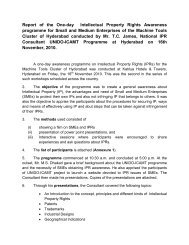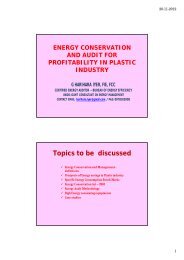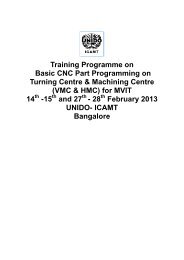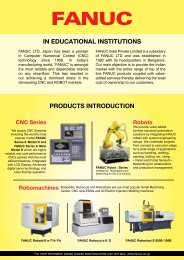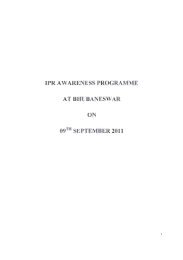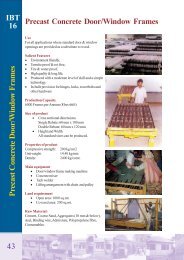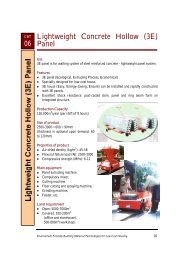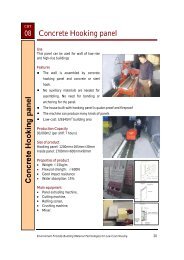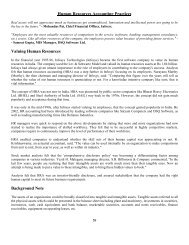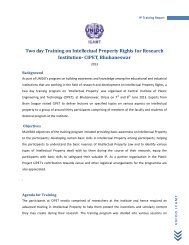Friction Welding & Friction Stir Welding - UNIDO-ICAMT
Friction Welding & Friction Stir Welding - UNIDO-ICAMT
Friction Welding & Friction Stir Welding - UNIDO-ICAMT
You also want an ePaper? Increase the reach of your titles
YUMPU automatically turns print PDFs into web optimized ePapers that Google loves.
In the afternoon Session of the first day, the participants were given hands on training on latest<strong>Friction</strong> <strong>Welding</strong> machines at ETA Technology. The working of different types of rotary andlinear <strong>Friction</strong> welding machines was demonstrated. The importance of setting correctparameters to achieve sound joints was practically explained on prototype components.In the morning of the second day’s session, four technical papers were presented, two papers on<strong>Friction</strong> <strong>Welding</strong> and two papers on <strong>Friction</strong> <strong>Stir</strong> welding Technology.Dr. K.A. Asokkumar, Additional General Manager, BHEL, Tiruchirappalli presented a talk on“<strong>Friction</strong> <strong>Welding</strong> – Process principles”. He described the practice of the friction welding intwo distinct modes; a. conventional or continuous drive friction welding and b. stored energy orinertia welding. He explained how the joint formation takes place in both the types of <strong>Friction</strong>welding and brought out the influence of rotary speed, pressure and heating time or burn off onthe joint efficiency. He also elaborated on the selection of typical parameters for continuousdrive <strong>Friction</strong> <strong>Welding</strong> and for Inertia <strong>Friction</strong> <strong>Welding</strong> for different types of similar anddissimilar materials joining. Dr. K.G.K. Murti, Professor, Head and Dean GRIET , Hyderabadgave a historical perspective on the evolution of <strong>Friction</strong> <strong>Welding</strong> Technology. He narrated theapplications of this technology in various engineering sectors. For example, <strong>Friction</strong> weldinghas been used in nuclear industry for joints between zirconium – aluminium – stainless steel,nickel – iron alloy / stainless steel and stainless steel / aluminium. In the aircraft industry also,friction welding finds application, e.g., for the joining of a turbine disc in a nickel – base alloy toturbine disc in a nickel – base alloy to a shaft in a gas turbine engine. The application of frictionwelding for the manufacture of nozzles of rocket motors and for joints between nodular cast ironpipe and steel pipe for construction use has been reported from Japan. Similarly the use offriction welding in the production of eccentric shafts for machine tools and agriculturalmachinery, the manufacture of bi-metal twist drills and the production of various types ofautomobile components has been reported from Europe.Dr G. Madhusudhan Reddy, Director, Defence Metallurgical Research Lab, Hyderabad delivereda talk on “<strong>Friction</strong> surfacing of metallic coatings on steels”. The topic was focused on how<strong>Friction</strong> surfacing machine has been employed to friction surface mild steel, Low Carbon LowAlloy Steel (LCLAS) and Medium Carbon Low Alloy Steel (MCLAS) with aluminum alloy6061, pure nickel, stainless steel, and aluminum metal matrix composites (MMC) AA 2124SiCp. Mild steel was coated with aluminum alloy, nickel, stainless steel, and MMC whileLCLAS was coated with stainless steel. MCLAS was friction surfaced with stainless steel as wellas nickel coating followed by stainless steel coating. Dr P. Srinivasa Rao, Scientist, LPSC, ISRO,Bangalore gave a lucid presentation on how <strong>Friction</strong> <strong>Stir</strong> <strong>Welding</strong> technology was adapted toSpace sector components. The stringent quality requirements were elaborated and how jigs andfixtures were designed and adopted to meet the dimensional accuracies.In the afternoon session, practical demonstrations on <strong>Friction</strong> <strong>Stir</strong> <strong>Welding</strong> with different typesof materials and edge configurations were given to the participants at IISC, Bangalore. Theparticipants had a lively interaction and got first hand information on various parameter settings.8



